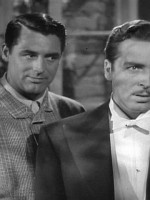Herman Cyril McNeile is a Scriptwriter British born on 27 september 1888

Herman Cyril McNeile, MC (28 September 1888 – 14 August 1937), commonly known as Cyril McNeile and publishing under the name H. C. McNeile or the pseudonym Sapper, was a British soldier and author. Drawing on his experiences in the trenches during the First World War, he started writing short stories and getting them published in the Daily Mail. As serving officers in the British Army were not permitted to publish under their own names, he was given the pen name "Sapper" by Lord Northcliffe, the owner of the Daily Mail; the nickname was based on that of his corps, the Royal Engineers.
After the war McNeile left the army and continued writing, although he changed from war stories to thrillers. In 1920 he published Bulldog Drummond, whose eponymous hero became his best-known creation. The character was based on McNeile himself, on his friend Gerard Fairlie and on English gentlemen generally. McNeile wrote ten Bulldog Drummond novels, as well as three plays and a screenplay.
McNeile interspersed his Drummond work with other novels and story collections that included two characters who appeared as protagonists in their own works, Jim Maitland and Ronald Standish. He was one of the most successful British popular authors of the inter-war period before his death in 1937 from throat cancer, which has been attributed to damage sustained from a gas attack in the war.
McNeile's stories are either directly about the war, or contain people whose lives have been shaped by it. His thrillers are a continuation of his war stories, with upper class Englishmen defending England from foreigners plotting against it. Although he was seen at the time as "simply an upstanding Tory who spoke for many of his countrymen", after the Second World War his work was criticised as having fascist overtones, while also displaying the xenophobia and anti-semitism apparent in some other writers of the period.
McNeile was born in Bodmin, Cornwall. He was the son of Malcolm McNeile, a captain in the Royal Navy who at the time was governor of the naval prison at Bodmin, and Christiana Mary (née Sloggett). The McNeile family had ancestral roots from both Belfast and Scotland, and counted a general in the British Indian Army among their members.
McNeile did not like either of his given names but preferred to be called Cyril, although he was always known by his friends as Mac. After attending a prep school in Eastbourne, he was further educated at Cheltenham College. On leaving the college, he joined the Royal Military Academy, Woolwich, from which he was commissioned into the Royal Engineers as a second lieutenant in July 1907. He underwent further training at the Royal School of Military Engineering before a short posting to Aldershot Garrison. He received promotion to lieutenant in June 1910 and was posted to Canterbury, serving three years with the 3rd Field Troop, until January 1914, when he was posted to Malta.
In 1914 McNeile was promoted to the rank of captain. He was still in Malta when the war broke out and was ordered to France in October 1914; he travelled via England and married Violet Evelyn Baird on 31 October 1914. Baird was the daughter of Lieutenant-Colonel Arthur Baird Douglas of the Cameron Highlanders.
First World War service
On 2 November 1914 McNeile travelled to France as part of the British Expeditionary Force. Few details are known about McNeile's wartime service, as his records were destroyed by incendiary bombs during the Second World War. He spent time with a number of Royal Engineer units on the Western Front, including 1st Field Squadron RE, 15th Field Company RE and RE elements of the 33rd Division.
McNeile's first known published story, Reminiscences of Sergeant Michael Cassidy, was serialised on page four of the Daily Mail from 13 January 1915. As serving officers in the British Army were not permitted to publish under their own names except during their half-pay sabbaticals, many would write under a pseudonym; Lord Northcliffe, the owner of the Daily Mail, gave McNeile the pen name "Sapper", as the Royal Engineers were commonly known as the Sappers. McNeile later confided that he had started writing through "sheer boredom". Some of his stories appeared on page four of the Daily Mail over the following months. Northcliffe was impressed by his writing and attempted, but failed, to have him released from the army to work as a war correspondent. By the end of 1915, he had written two collections of short stories, The Lieutenant and Others and Sergeant Michael Cassidy, R.E., both of which were published by Hodder & Stoughton. Although many of the stories had already appeared in the Daily Mail, between 1916 and 1918 Sergeant Michael Cassidy, R.E. sold 135,000 copies and The Lieutenant and Others sold 139,000 copies. By the end of the war he had published three more collections, Men, Women, and Guns (1916), No Man's Land (1917) and The Human Touch (1918). In 1916 he wrote a series of articles titled The Making of an Officer, which appeared under the initials C. N., in five issues of The Times between 8 and 14 June 1916. The articles were aimed at young and new officers to explain their duties to them; these were collected together and published by Hodder & Stoughton later in 1916.
During his time with the Royal Engineers, McNeile saw action at the First and Second Battles of Ypres—he was gassed at the second battle—and the Battle of the Somme. In 1916, he was awarded the Military Cross and was mentioned in dispatches; in November that year he was gazetted to acting major. From 1 April to 5 October 1918, he commanded a battalion of the Middlesex Regiment and was promoted to acting lieutenant-colonel; the scholar Lawrence Treadwell observes that "for an engineer to command an infantry regiment was ... a rarity". 18th Battalion, Middlesex Regiment under McNeile saw action for the remainder of his command, and were involved in fighting during the Hundred Days Offensive in the St. Quentin-Cambrai sector in September 1918; during the year, he was again mentioned in dispatches. On 2 October 1918 he broke his ankle and was briefly hospitalised, which forced him to relinquish his command of the regiment on 4 October. He was on convalescent leave when the war ended in November 1918. During the course of the war, he had spent a total of 32 months in France, and had probably been gassed more than once. His literary output from 1915 to 1918 accounted for more than 80 collected and uncollected stories. His brother—also in the Royal Engineers—had been killed earlier in the war.
Post-war years
McNeile had a quiet life after the war; his biographer Jonathon Green notes that "as in the novels of fellow best-selling writers such as P. G. Wodehouse or Agatha Christie, it is the hero who lives the exciting life". Although he was an "unremittingly hearty man", he suffered from delicate health following the war. He had a loud voice and a louder laugh, and "liked to enliven clubs and restaurants with the sight and sound of military good fellowship"; his friend and collaborator Gerard Fairlie described him as "not everybody's cup of tea", and commented that "he was loud in every possible way—in his voice, in his laugh, in his clothes, in the unconscious swagger with which he always motivated himself, in his whole approach to life". McNeile and his wife had two sons.
On 13 June 1919 McNeile retired onto the reserve officer list and was confirmed in the rank of major. The same year he also published a short-story collection, Mufti, in which he introduced a type of character as "the Breed", a class of Englishman who was patriotic, loyal and "physically and morally intrepid". Although well received by the critics, the book failed commercially and, by the end of 1922, had only sold 16,700 copies from its first print run of 20,000; the unsold copies were pulped and the novel went out of print later that year.
"Demobilised officer, ... finding peace incredibly tedious, would welcome diversion. Legitimate, if possible; but crime, if of a comparatively humorous description, no objection. Excitement essential."
Advertisement placed in The Times by Drummond in Bulldog Drummond
In 1920 McNeile published Bull-Dog Drummond, whose eponymous hero—a member of "the Breed"—became his most famous creation. He had first written Drummond as a detective for a short story in The Strand Magazine, but the character was not successful and was changed for the novel, which was a thriller. Captain Hugh "Bulldog" Drummond DSO, MC was described in the novel's sub-title as "a demobilised officer who found peace dull" after service during the First World War with the fictional Loamshire Regiment. Drummond went on to appear in ten full-length novels by McNeile and a further seven by his friend Gerard Fairlie. The character was an amalgam of Fairlie, himself, and his idea of an English gentleman. Drummond also had roots in the literary characters Sherlock Holmes, Sexton Blake, Richard Hannay and The Scarlet Pimpernel. Drummond was characterised as large, very strong, physically unattractive and an "apparently brainless hunk of a man", who was also a gentleman with a private income; he could also be construed as "a brutalized ex-officer whose thirst for excitement is also an attempt to reenact [sic] the war". The character was later described by Cecil Day-Lewis as an "unspeakable public school bully". Drummond's main adversary across four novels is Carl Peterson, a master criminal with no national allegiance, who is often accompanied by his wife, Irma. Irma is described by Jonathon Green as "the slinky epitome of a twenties 'vamp'", and by Lawrence Treadwell as dark, sexy and from an oriental background, "a true femme fatale". After Carl Peterson's death in The Final Count, Irma swears revenge on Drummond and kidnaps his wife—whom he had met in Bull-Dog Drummond—with the intent of killing him in the ensuing chase. Irma Peterson appears in six of McNeile's books, and in a further five by Fairlie.
McNeile adapted Bulldog Drummond for the stage. It was shown at Wyndham's Theatre during the 1921–22 season, with Gerald du Maurier playing the title role; it ran for 428 performances. The play also ran in New York during the same season, with A. E. Matthews as Drummond. Later in 1922 McNeile resigned his reserve commission with the rank of lieutenant-colonel, and moved as a tax exile to Territet, Montreux, Switzerland, with his wife; the Swiss countryside was later described in a number of his stories.
The following year McNeile introduced the character of Jim Maitland, a "footloose sahib of the period". Maitland was the protagonist of the 1923 novel Jim Maitland; he later appeared in a second novel in 1931, The Island of Terror. Around the time McNeile killed off the Carl Peterson character in The Final Count (1926), he also introduced the character Ronald Standish, who first appeared in "The Saving Clause" (1927) and "Tiny Carteret" (1930) before becoming the protagonist in two collections of short stories, Ronald Standish (1933) and Ask for Ronald Standish (1936). The character also appeared in the final three Drummond novels, Knock-Out (1933), Bull-Dog Drummond at Bay (1935) and Challenge (1937). Standish was a sportsman who played cricket for England and was a part-time consultant with the War Office.
In 1929 McNeile edited a volume of short stories from O. Henry, The Best of O. Henry; the stories had served as models for him when he had started as a writer. The same year, the film Bulldog Drummond was released, starring Ronald Colman in the title role. Colman was nominated for an Academy Award for Best Actor at the 3rd Academy Awards ceremony. The film earned $750,000 at the box office, and McNeile received an estimated £5,000 for the rights to his novel. The same year he wrote his second play—The Way Out—which was staged at the Comedy Theatre in January 1930. About a year later he and his wife returned to England, and settled near Pulborough, West Sussex.
In 1935 McNeile, Fairlie, Sidney Gilliat and J.O.C. Orton collaborated on the screenplay Bulldog Jack, a "comedy thriller" with Jack Hulbert and Fay Wray, which was produced by Gaumont British.
Death and legacy
In 1937 McNeile was working with Fairlie on the play Bulldog Drummond Hits Out when he was diagnosed with terminal throat cancer. He came to an agreement with Fairlie for the play to continue after his death and for Fairlie to continue writing the Drummond stories. McNeile died on 14 August 1937 at his home in West Chiltington, West Sussex. Although most sources identify throat cancer as the cause of death, Treadwell also suggests that it may have been lung cancer. It was "traceable to his war service", and attributed to a gas attack. His funeral, with full military honours, was conducted at Woking crematorium. At his death his estate was valued at over £26,000.
Bulldog Drummond Hits Out was finished by Fairlie and had a short tour of Brighton, Birmingham, Manchester and Edinburgh, before opening in London at the Savoy Theatre on 21 December 1937. The story was later turned into a novel by Fairlie, with the title Bulldog Drummond on Dartmoor. Fairlie continued to write Drummond novels, seven in total.
Drummond, McNeile's chief literary legacy, became a model for other literary heroes created in the 1940s and '50s. W. E. Johns used McNeile's work as a model for his character Biggles, while Ian Fleming admitted that James Bond was "Sapper from the waist up and Mickey Spillane below". Sydney Horler's popular character "Tiger" Standish was also modelled on Drummond.
Source : Wikidata
Herman Cyril McNeile

- Infos
- Photos
- Best films
- Family
- Characters
- Awards
Birth name Herman Cyril McNeile
Nationality United-kingdom
Birth 27 september 1888
Death 14 august 1937 (at 48 years)
Awards Military Cross
Nationality United-kingdom
Birth 27 september 1888
Death 14 august 1937 (at 48 years)
Awards Military Cross
After the war McNeile left the army and continued writing, although he changed from war stories to thrillers. In 1920 he published Bulldog Drummond, whose eponymous hero became his best-known creation. The character was based on McNeile himself, on his friend Gerard Fairlie and on English gentlemen generally. McNeile wrote ten Bulldog Drummond novels, as well as three plays and a screenplay.
McNeile interspersed his Drummond work with other novels and story collections that included two characters who appeared as protagonists in their own works, Jim Maitland and Ronald Standish. He was one of the most successful British popular authors of the inter-war period before his death in 1937 from throat cancer, which has been attributed to damage sustained from a gas attack in the war.
McNeile's stories are either directly about the war, or contain people whose lives have been shaped by it. His thrillers are a continuation of his war stories, with upper class Englishmen defending England from foreigners plotting against it. Although he was seen at the time as "simply an upstanding Tory who spoke for many of his countrymen", after the Second World War his work was criticised as having fascist overtones, while also displaying the xenophobia and anti-semitism apparent in some other writers of the period.
Biography
Early lifeMcNeile was born in Bodmin, Cornwall. He was the son of Malcolm McNeile, a captain in the Royal Navy who at the time was governor of the naval prison at Bodmin, and Christiana Mary (née Sloggett). The McNeile family had ancestral roots from both Belfast and Scotland, and counted a general in the British Indian Army among their members.
McNeile did not like either of his given names but preferred to be called Cyril, although he was always known by his friends as Mac. After attending a prep school in Eastbourne, he was further educated at Cheltenham College. On leaving the college, he joined the Royal Military Academy, Woolwich, from which he was commissioned into the Royal Engineers as a second lieutenant in July 1907. He underwent further training at the Royal School of Military Engineering before a short posting to Aldershot Garrison. He received promotion to lieutenant in June 1910 and was posted to Canterbury, serving three years with the 3rd Field Troop, until January 1914, when he was posted to Malta.
In 1914 McNeile was promoted to the rank of captain. He was still in Malta when the war broke out and was ordered to France in October 1914; he travelled via England and married Violet Evelyn Baird on 31 October 1914. Baird was the daughter of Lieutenant-Colonel Arthur Baird Douglas of the Cameron Highlanders.
First World War service
On 2 November 1914 McNeile travelled to France as part of the British Expeditionary Force. Few details are known about McNeile's wartime service, as his records were destroyed by incendiary bombs during the Second World War. He spent time with a number of Royal Engineer units on the Western Front, including 1st Field Squadron RE, 15th Field Company RE and RE elements of the 33rd Division.
McNeile's first known published story, Reminiscences of Sergeant Michael Cassidy, was serialised on page four of the Daily Mail from 13 January 1915. As serving officers in the British Army were not permitted to publish under their own names except during their half-pay sabbaticals, many would write under a pseudonym; Lord Northcliffe, the owner of the Daily Mail, gave McNeile the pen name "Sapper", as the Royal Engineers were commonly known as the Sappers. McNeile later confided that he had started writing through "sheer boredom". Some of his stories appeared on page four of the Daily Mail over the following months. Northcliffe was impressed by his writing and attempted, but failed, to have him released from the army to work as a war correspondent. By the end of 1915, he had written two collections of short stories, The Lieutenant and Others and Sergeant Michael Cassidy, R.E., both of which were published by Hodder & Stoughton. Although many of the stories had already appeared in the Daily Mail, between 1916 and 1918 Sergeant Michael Cassidy, R.E. sold 135,000 copies and The Lieutenant and Others sold 139,000 copies. By the end of the war he had published three more collections, Men, Women, and Guns (1916), No Man's Land (1917) and The Human Touch (1918). In 1916 he wrote a series of articles titled The Making of an Officer, which appeared under the initials C. N., in five issues of The Times between 8 and 14 June 1916. The articles were aimed at young and new officers to explain their duties to them; these were collected together and published by Hodder & Stoughton later in 1916.
During his time with the Royal Engineers, McNeile saw action at the First and Second Battles of Ypres—he was gassed at the second battle—and the Battle of the Somme. In 1916, he was awarded the Military Cross and was mentioned in dispatches; in November that year he was gazetted to acting major. From 1 April to 5 October 1918, he commanded a battalion of the Middlesex Regiment and was promoted to acting lieutenant-colonel; the scholar Lawrence Treadwell observes that "for an engineer to command an infantry regiment was ... a rarity". 18th Battalion, Middlesex Regiment under McNeile saw action for the remainder of his command, and were involved in fighting during the Hundred Days Offensive in the St. Quentin-Cambrai sector in September 1918; during the year, he was again mentioned in dispatches. On 2 October 1918 he broke his ankle and was briefly hospitalised, which forced him to relinquish his command of the regiment on 4 October. He was on convalescent leave when the war ended in November 1918. During the course of the war, he had spent a total of 32 months in France, and had probably been gassed more than once. His literary output from 1915 to 1918 accounted for more than 80 collected and uncollected stories. His brother—also in the Royal Engineers—had been killed earlier in the war.
Post-war years
McNeile had a quiet life after the war; his biographer Jonathon Green notes that "as in the novels of fellow best-selling writers such as P. G. Wodehouse or Agatha Christie, it is the hero who lives the exciting life". Although he was an "unremittingly hearty man", he suffered from delicate health following the war. He had a loud voice and a louder laugh, and "liked to enliven clubs and restaurants with the sight and sound of military good fellowship"; his friend and collaborator Gerard Fairlie described him as "not everybody's cup of tea", and commented that "he was loud in every possible way—in his voice, in his laugh, in his clothes, in the unconscious swagger with which he always motivated himself, in his whole approach to life". McNeile and his wife had two sons.
On 13 June 1919 McNeile retired onto the reserve officer list and was confirmed in the rank of major. The same year he also published a short-story collection, Mufti, in which he introduced a type of character as "the Breed", a class of Englishman who was patriotic, loyal and "physically and morally intrepid". Although well received by the critics, the book failed commercially and, by the end of 1922, had only sold 16,700 copies from its first print run of 20,000; the unsold copies were pulped and the novel went out of print later that year.
"Demobilised officer, ... finding peace incredibly tedious, would welcome diversion. Legitimate, if possible; but crime, if of a comparatively humorous description, no objection. Excitement essential."
Advertisement placed in The Times by Drummond in Bulldog Drummond
In 1920 McNeile published Bull-Dog Drummond, whose eponymous hero—a member of "the Breed"—became his most famous creation. He had first written Drummond as a detective for a short story in The Strand Magazine, but the character was not successful and was changed for the novel, which was a thriller. Captain Hugh "Bulldog" Drummond DSO, MC was described in the novel's sub-title as "a demobilised officer who found peace dull" after service during the First World War with the fictional Loamshire Regiment. Drummond went on to appear in ten full-length novels by McNeile and a further seven by his friend Gerard Fairlie. The character was an amalgam of Fairlie, himself, and his idea of an English gentleman. Drummond also had roots in the literary characters Sherlock Holmes, Sexton Blake, Richard Hannay and The Scarlet Pimpernel. Drummond was characterised as large, very strong, physically unattractive and an "apparently brainless hunk of a man", who was also a gentleman with a private income; he could also be construed as "a brutalized ex-officer whose thirst for excitement is also an attempt to reenact [sic] the war". The character was later described by Cecil Day-Lewis as an "unspeakable public school bully". Drummond's main adversary across four novels is Carl Peterson, a master criminal with no national allegiance, who is often accompanied by his wife, Irma. Irma is described by Jonathon Green as "the slinky epitome of a twenties 'vamp'", and by Lawrence Treadwell as dark, sexy and from an oriental background, "a true femme fatale". After Carl Peterson's death in The Final Count, Irma swears revenge on Drummond and kidnaps his wife—whom he had met in Bull-Dog Drummond—with the intent of killing him in the ensuing chase. Irma Peterson appears in six of McNeile's books, and in a further five by Fairlie.
McNeile adapted Bulldog Drummond for the stage. It was shown at Wyndham's Theatre during the 1921–22 season, with Gerald du Maurier playing the title role; it ran for 428 performances. The play also ran in New York during the same season, with A. E. Matthews as Drummond. Later in 1922 McNeile resigned his reserve commission with the rank of lieutenant-colonel, and moved as a tax exile to Territet, Montreux, Switzerland, with his wife; the Swiss countryside was later described in a number of his stories.
The following year McNeile introduced the character of Jim Maitland, a "footloose sahib of the period". Maitland was the protagonist of the 1923 novel Jim Maitland; he later appeared in a second novel in 1931, The Island of Terror. Around the time McNeile killed off the Carl Peterson character in The Final Count (1926), he also introduced the character Ronald Standish, who first appeared in "The Saving Clause" (1927) and "Tiny Carteret" (1930) before becoming the protagonist in two collections of short stories, Ronald Standish (1933) and Ask for Ronald Standish (1936). The character also appeared in the final three Drummond novels, Knock-Out (1933), Bull-Dog Drummond at Bay (1935) and Challenge (1937). Standish was a sportsman who played cricket for England and was a part-time consultant with the War Office.
In 1929 McNeile edited a volume of short stories from O. Henry, The Best of O. Henry; the stories had served as models for him when he had started as a writer. The same year, the film Bulldog Drummond was released, starring Ronald Colman in the title role. Colman was nominated for an Academy Award for Best Actor at the 3rd Academy Awards ceremony. The film earned $750,000 at the box office, and McNeile received an estimated £5,000 for the rights to his novel. The same year he wrote his second play—The Way Out—which was staged at the Comedy Theatre in January 1930. About a year later he and his wife returned to England, and settled near Pulborough, West Sussex.
In 1935 McNeile, Fairlie, Sidney Gilliat and J.O.C. Orton collaborated on the screenplay Bulldog Jack, a "comedy thriller" with Jack Hulbert and Fay Wray, which was produced by Gaumont British.
Death and legacy
In 1937 McNeile was working with Fairlie on the play Bulldog Drummond Hits Out when he was diagnosed with terminal throat cancer. He came to an agreement with Fairlie for the play to continue after his death and for Fairlie to continue writing the Drummond stories. McNeile died on 14 August 1937 at his home in West Chiltington, West Sussex. Although most sources identify throat cancer as the cause of death, Treadwell also suggests that it may have been lung cancer. It was "traceable to his war service", and attributed to a gas attack. His funeral, with full military honours, was conducted at Woking crematorium. At his death his estate was valued at over £26,000.
Bulldog Drummond Hits Out was finished by Fairlie and had a short tour of Brighton, Birmingham, Manchester and Edinburgh, before opening in London at the Savoy Theatre on 21 December 1937. The story was later turned into a novel by Fairlie, with the title Bulldog Drummond on Dartmoor. Fairlie continued to write Drummond novels, seven in total.
Drummond, McNeile's chief literary legacy, became a model for other literary heroes created in the 1940s and '50s. W. E. Johns used McNeile's work as a model for his character Biggles, while Ian Fleming admitted that James Bond was "Sapper from the waist up and Mickey Spillane below". Sydney Horler's popular character "Tiger" Standish was also modelled on Drummond.
Best films
Usually with
Filmography of Herman Cyril McNeile (25 films)
Scriptwriter
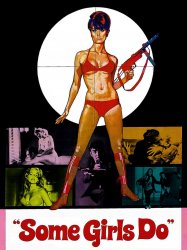
Some Girls Do (1969)
, 1h28Directed by Ralph Thomas
Origin United-kingdom
Genres Comedy, Action, Adventure, Spy
Themes Spy films, Transport films, Aviation films
Actors Richard Johnson, Daliah Lavi, Beba Loncar, James Villiers, Florence Desmond, Maurice Denham
Roles Characters
Rating56%





Drummond is hired after a series of inexplicable accidents befall the people and companies who are responsible for developing the world's first supersonic airliner, the SST1. Drummond, with the help of another agent, uncovers a plot by a mastermind named Carl Petersen, who stands to gain eight million pounds if the aircraft is not ready by a certain date. Petersen has developed a number of robots: beautiful girls with electronic brains to help him sabotage the SST1 project by means of infrasound (sound waves with too low frequency to be detected by the human ear) which can be directed at people or objects with devastating results.

Deadlier Than the Male (1967)
, 1h41Directed by Ralph Thomas
Origin United-kingdom
Genres Thriller, Comedy, Action, Adventure, Crime
Themes Seafaring films, Transport films
Actors Richard Johnson, Elke Sommer, Sylva Koscina, Nigel Green, Virginia North, Suzanna Leigh
Roles Characters
Rating62%





When a top oil executive dies mysteriously aboard his private jet, the company's board suspects foul play and hires Hugh "Bulldog" Drummond to investigate. Attempts on his own life lead him to believe two lovely females are "hit men" for an international crime syndicate.

Calling Bulldog Drummond (1951)
, 1h20Directed by Victor Saville
Origin United-kingdom
Genres Crime
Actors Walter Pidgeon, Robert Beatty, Margaret Leighton, David Tomlinson, Charles Victor, Bernard Lee
Roles Characters
Rating61%





After three robberies are pulled off with military precision, Inspector McIver (Charles Victor) asks Hugh "Bulldog" Drummond (Walter Pidgeon) to give Scotland Yard a hand. As an ex-officer, Drummond knows how the suspected military mastermind would think. He agrees, though he very reluctantly accepts Sergeant Helen Smith (Margaret Leighton) of Special Branch as his partner, believing that women are not cut out for that sort of undercover work.
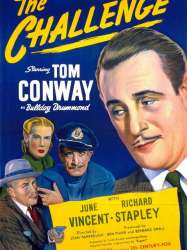
The Challenge (1948)
, 1h8Directed by Jean Yarbrough
Origin USA
Actors Tom Conway, Tim Conway, June Vincent, John Newland, Eily Malyon, Houseley Stevenson
Roles Novel
Rating64%






Bulldog Drummond at Bay (1947)
, 1h10Directed by Sidney Salkow
Origin United-kingdom
Genres Adventure, Crime
Actors Ron Randell, Anita Louise, Terry Kilburn, Holmes Herbert, Lester Matthews, Leonard Mudie
Roles Characters
Rating67%





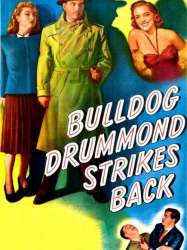 , 1h5
, 1h5Directed by Frank McDonald
Origin USA
Genres Drama, Action, Crime
Actors Ron Randell, Gloria Henry, Terry Kilburn, Holmes Herbert, Wilton Graff, Matthew Boulton
Roles Novel
Rating65%





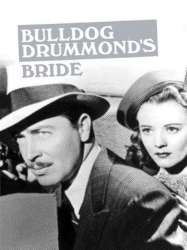
Bulldog Drummond's Bride (1939)
, 56minutesDirected by James Patrick Hogan
Origin USA
Genres Thriller, Action, Crime
Actors John Howard, Heather Angel, H. B. Warner, Reginald Denny, E. E. Clive, Elizabeth Patterson
Roles Novel
Rating59%





In London a shape charge wielding master-criminal comes up with a foolproof plan for robbing a bank and outwitting Scotland Yard's pursuit, but during the getaway he hides his haul in a radio set in the apartment of a certain Capt. Bulldog Drummond, leading to a murder, punch-ups, an expedition to France, and a night in a French jail cell and a break-out, in a race to reach Bulldog's fiancee - who has taken the radio set with her on holiday unaware of its contents - before the villain does: ending in a roof-top fight and the Bulldog finally tying the matrimonial knot in an explosive finale to his bachelorhood.
 , 56minutes
, 56minutesDirected by James Patrick Hogan
Origin USA
Genres Thriller, Crime
Actors John Howard, Leo G. Carroll, Heather Angel, E. E. Clive, H. B. Warner, Reginald Denny
Roles Novel
Rating60%





An absent minded Professor Downie makes a call upon Drummond as he is making plans for his much-delayed wedding to fiancee Phyllis Claverling. The professor informs Drummond that a fortune was buried in one of the walled off storerooms underneath his estate, and that Downie was in possession of a book written in code that would lead them to discover the treasure. Unfortunately for the professor, someone else also wanted the riches and Drummond once again is dragged into the plot as the code book is stolen, Professor Downie is murdered, and Phyllis is kidnapped.

Bulldog Drummond in Africa (1938)
, 58minutesDirected by Louis King
Origin USA
Genres Action, Adventure, Crime
Themes Films set in Africa
Actors John Howard, Heather Angel, H. B. Warner, J. Carrol Naish, Reginald Denny, E. E. Clive
Roles Novel
Rating59%





On the eve of his wedding Captain Hugh Drummond (John Howard) has more pressing concerns when he sets off from London for Morocco after a Scotland Yard Commander is kidnapped by an international criminal intent on forcing him to reveal the secrets of the British Empire's latest military technology. With his fiancée (Heather Angel), chum 'Algy' (Reginald Denny), & valet 'Tenny' Tennyson (E.E. Clive) in tow, Bulldog outwits Scotland Yard's bureaucratic blundering, flies his own plane 1200 miles only to find more bureaucratic blundering by the local British Consul ordering him home without delay. Drummond isn't an easy man to get rid of however and soon mounts a rescue plan, liberating the Commander, saving the Empire and throwing the villain to his own captive lions in the process.
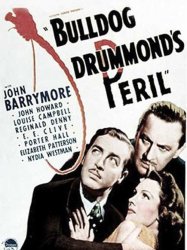
Bulldog Drummond's Peril (1938)
Directed by James Patrick Hogan
Origin USA
Genres Thriller, Action, Adventure, Crime, Romance
Actors John Barrymore, John Howard, Reginald Denny, E. E. Clive, Porter Hall, Elizabeth Patterson
Roles Novel
Rating59%





The intended wedding of Captain Hugh "Bulldog" Drummond to Phyllis Clavering at her villa in Switzerland is stopped short (once again) when someone murders the Swiss policeman who is guarding their wedding presents. The killer makes off with their prize possession, a synthetic diamond, made by a secret process by Professor Bernard Goodman, the father of their good friend Gwen Longworth. A guest, Sir Raymond Blantyre, head of the Metropolitan Diamond Syndicate, disappears at the same time, and Drummond suspects that Sir Raymond, who has the most to lose if Professor Goodman proceeds with his plans to publish his secret process, has something to do with the theft. He leaves Phyllis and chases back to England. Colonel Nielsen, of Scotland Yard, as usual scoffs at Drummond's suspicions and insists that a man as respected as Sir Raymond could not possibly be involved in such a crime. But, as usual, he has Drummond followed just in the event he turns up something unexpected. An explosion that wrecks Goodman's house, and apparently kills him, makes Drummond more positive that the diamond king has again resorted to murder to protect his business. He follows Professor Botulian, a lifelong rival of Goodman's, whom he believes to be involved in the affair. His hunt leads him to a lonely house on the outskirts of London where he finds Goodman a prisoner. Before they can escape, Drummond and Goodman are joined by Tenny (E. E. Clive), his valet, and Phyllis, who are also (as usual) being held by the crooks.

Arrest Bulldog Drummond (1938)
, 57minutesDirected by James Patrick Hogan
Origin USA
Genres Science fiction, Thriller, Action
Actors John Howard, Heather Angel, H. B. Warner, Reginald Denny, E. E. Clive, Zeffie Tilbury
Roles Novel
Rating61%





Bulldog & Algy, in the midst of preparations for the former's wedding in London, are summoned to more important matters at the house of an eccentric scientist who has invented a prototype electric "death-ray" device, which has the potential to revolutionize warfare. They find the scientist murdered in mysterious circumstances upon their arrival, and set out on an adventure to find out what's going on and the culprit, aka The Stinger - leading to a spot of bother with Scotland Yard, a dock-yard knife-fight which puts the Bulldog on the missing in action list temporarily, and a trip to the Tropics to foil a master-criminal's attempt to sell the British Empire threatening secret-weapon to a foreign power for the highest price.
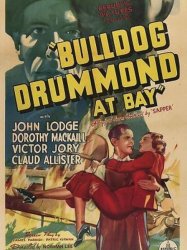
Bulldog Drummond at Bay (1937)
, 1h18Directed by Norman Lee
Origin United-kingdom
Genres Drama, Thriller, Action
Actors John Lodge, Dorothy Mackaill, Victor Jory, Claud Allister, Richard Bird, Wilfrid Hyde-White
Roles Novel
Rating58%





Bulldog Drummond goes up against a gang of foreign agents who are members of a British pacifist organisation called "The Key". The agents kidnap an inventor to discover the steal plans for a top-secret robot aircraft.
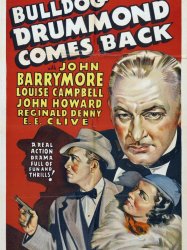
Bulldog Drummond Comes Back (1937)
, 1h4Directed by Louis King
Origin USA
Genres Thriller, Action, Crime
Actors John Barrymore, John Howard, Reginald Denny, E. E. Clive, J. Carrol Naish, Helen Freeman
Roles Novel
Rating59%





Phyllis Clavering (Louise Campbell), the girlfriend of Captain Drummond (John Howard) is kidnapped by an enemy of Drummond, wanted for murder Mikhail Valdin (J. Carroll Naish) and his sister, Erena Soldanis (Helen Freeman), who are seeking revenge, but Drummond and his friend Colonel Nielsen (John Barrymore) are hot on his trail.

Bulldog Drummond Escapes (1937)
, 1h7Directed by James Patrick Hogan
Origin USA
Genres Thriller, Action, Adventure, Romance
Actors Ray Milland, Heather Angel, Guy Standing, Reginald Denny, Porter Hall, Fay Holden
Roles Theatre Play
Rating60%





Captain Hugh 'Bulldog' Drummond (Ray Milland) has just returned to England. As he is driving home in the dark, a young woman jumps out in front of his car. He misses Phyllis Clavering (Heather Angel), but she falls to the ground. As he tries to revive her, he hears a shout for help, then gunshots. As he goes to investigate, the woman drives away with Drummond's car. He is soon able to trace her to nearby Greystone Manor, and when he goes there to meet her, she urges him to help her get out of a desperate situation.
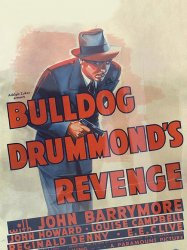
Bulldog Drummond's Revenge (1937)
, 57minutesDirected by Louis King
Origin USA
Genres Adventure, Crime
Themes Transport films, Rail transport films
Actors John Barrymore, John Howard, Reginald Denny, E. E. Clive, Frank Puglia, Nydia Westman
Roles Novel
Rating58%





The film tells the story of Captain Hugh "Bulldog" Drummond, a British officer who, while on a drive with his friend Algy Longworth and valet Tenny, is the first to discover a mysterious suitcase that is parachuted from an aircraft above, minutes before the plane crashes. The case is found to contain a highly explosive chemical, the plans for which have been stolen, and despite the urging of his fiancee Phyllis Claverling, Drummond is dragged into the mystery surrounding the whole affair, traveling by both train and ship to recover the formula.
 Connection
Connection





